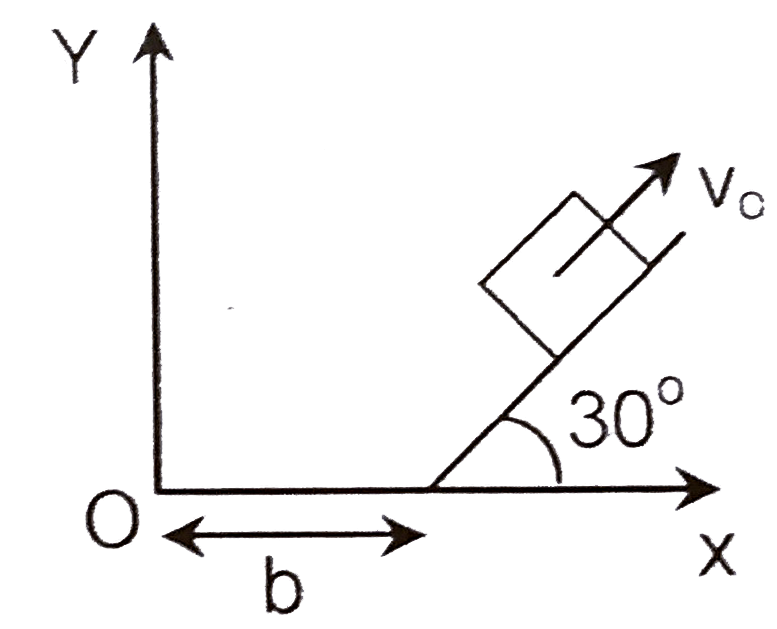A particle of mass m=5 units is moving with a uniform speed v=3√2 units in the XY-plane along the y=x+4. The magnitude of the angular momentum about origin is
zero
60 unit
7.5 unit
40√2 unit
The correct Answer is:B
To find the magnitude of the angular momentum of a particle moving along a line in the XY-plane, we can follow these steps:
Step 1: Understand the motion of the particle
The particle has a mass m=5 units and is moving with a uniform speed v=3√2 units along the line given by the equation y=x+4.
Step 2: Determine the slope and angle of the line
The line y=x+4 has a slope m=1. This means that the angle θ that the line makes with the x-axis can be calculated using:
tan(θ)=1⟹θ=45∘
Step 3: Find the perpendicular distance from the origin to the line
To find the perpendicular distance r⊥ from the origin (0,0) to the line y=x+4, we can use the formula for the distance from a point to a line:
Distance=|Ax+By+C|√A2+B2
For the line y=x+4, we can rewrite it in the form Ax+By+C=0:
x−y+4=0⇒A=1,B=−1,C=4
Now, substituting the origin coordinates (x,y)=(0,0):
Distance=|1(0)−1(0)+4|√12+(−1)2=4√2=2√2
Step 4: Calculate the angular momentum
The angular momentum L about the origin is given by the formula:
L=m⋅v⋅r⊥
Substituting the known values:
L=5⋅(3√2)⋅(2√2)
Calculating this step by step:
1. Calculate 3√2⋅2√2:
3√2⋅2√2=3⋅2⋅2=12
2. Now multiply by the mass:
L=5⋅12=60
Final Answer
The magnitude of the angular momentum about the origin is L=60 units.
---
The particle has a mass m=5 units and is moving with a uniform speed v=3√2 units along the line given by the equation y=x+4.
The line y=x+4 has a slope m=1. This means that the angle θ that the line makes with the x-axis can be calculated using:
tan(θ)=1⟹θ=45∘
To find the perpendicular distance r⊥ from the origin (0,0) to the line y=x+4, we can use the formula for the distance from a point to a line:
Distance=|Ax+By+C|√A2+B2
For the line y=x+4, we can rewrite it in the form Ax+By+C=0:
x−y+4=0⇒A=1,B=−1,C=4
Now, substituting the origin coordinates (x,y)=(0,0):
Distance=|1(0)−1(0)+4|√12+(−1)2=4√2=2√2
The angular momentum L about the origin is given by the formula:
L=m⋅v⋅r⊥
Substituting the known values:
L=5⋅(3√2)⋅(2√2)
Calculating this step by step:
1. Calculate 3√2⋅2√2:
3√2⋅2√2=3⋅2⋅2=12
2. Now multiply by the mass:
L=5⋅12=60
The magnitude of the angular momentum about the origin is L=60 units.
Topper's Solved these Questions
- BOOK - DC PANDEY ENGLISHCHAPTER - ROTATIONEXERCISE - (B) Chapter Exercises25videos
ROTATION
- BOOK - DC PANDEY ENGLISHCHAPTER - ROTATIONEXERCISE - (C) Chapter Exercises39videos
ROTATION
- BOOK - DC PANDEY ENGLISHCHAPTER - ROTATIONEXERCISE - Check point 9.315videos
ROTATION
- BOOK - DC PANDEY ENGLISHCHAPTER - RAY OPTICSEXERCISE - Integer type q.14videos
RAY OPTICS
- BOOK - DC PANDEY ENGLISHCHAPTER - ROTATIONAL MECHANICSEXERCISE - Subjective Questions2videos
ROTATIONAL MECHANICS
Similar Questions
A particle of mass 5g is moving with a uniform speed of 3√2cm/s in the x−y plane along the line y=x+4. The magnitude of its angular momentum about the origin in gcm2/s is
View SolutionA particle of mass 5 g is moving with a uniform speed of 3√2cm s−1 in the XY-plane along the line y=2√5 cm. The magnitude of its angular momentum about the origin in g-cm2s−1 is
View SolutionA particle of mass 1 kg is moving along the line y=x+2 (here x and y are in metres) with speed 2m/s. The magnitude of angular momentum of paticle about origin is -
View SolutionA disc of mass M and Radius R is rolling with an angular speed ω on the horizontal plane. The magnitude of angular momentum of the disc about origin is:
View SolutionA particle of mass 300 g is moving with a speed of 20 ms−1 along the straight line y = x - 4√2. The angular momentum of the particle about the origin is (where y & x are in metres)
View SolutionA particle of mass m=3kg moves along a straight line 4y−3x=2 where x and y are in metre, with constant velocity v=5ms−1 the magnitude of angular momentum about the origin is
View SolutionA particle of mass m is moving with constant speed v on the line y=b in positive x-direction. Find its angular momentum about origin, when position coordinates of the particle are (a, b).
View SolutionA particle is moving with constant speed v in xy plane as shown in figure. The magnitude of its angular velocity about point O is
 View Solution
View SolutionA cube of mass m and side a is moving along a plane with constant speed vo as shown in figure. The magnitude of angular momentum of the cube about z -axis would be.
 View Solution
View SolutionA particle of mass m is projected with velocity v moving at an angle of 45∘ with horizontal. The magnitude of angular momentum of projectile about point of projection when particle is at maximum height, is
View Solution

